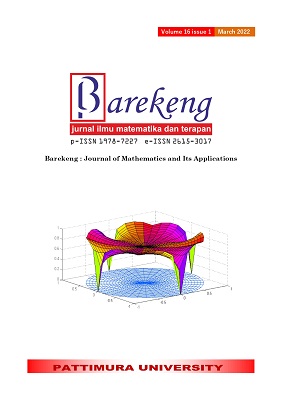MEDICAL IMAGE ENCRYPTION USING DNA ENCODING AND MODIFIED CIRCULAR SHIFT
Abstract
This paper proposes a new encryption method for the encryption of medical images. The method is used to divide the image into several blocks and then scramble the image blocks using DNA chains and then shift the pixels in a circle with certain rules. To provide a more secure result, the input key contains a DNA chain and is equipped with complementary rules, and is converted into a hexadecimal number using a DNA coding table. Experimental results and values of NPCR and UACI show that the scheme achieves good encryption and decryption results.
Downloads
References
S. Paul, P. Dasgupta, P. K. Naskar, and A. Chaudhuri, “Secured image encryption scheme based on DNA encoding and chaotic map,” p. 6.
D. Puspa, A. Soegiharto, A. Nizar Hidayanto, and Q. Munajat, “Data Privacy, What Still Need Consideration in Online Application System?,” J. Sist. Inf., vol. 16, no. 1, pp. 49–63, Apr. 2020, doi: 10.21609/jsi.v16i1.941.
S. Y. Wulandari, “Cryptography: A Combination of Caesar and Affine Cipher to Conceal the Message,” Proceeding Int. Conf. Sci. Eng., vol. 3, pp. 741–744, Apr. 2020, doi: 10.14421/icse.v3.595.
D. E. Agrawal and D. J. Jain, “A Review on Various Methods of Cryptography for Cyber Security,” Int. J. Recent Innov. Trends Comput. Commun., vol. 6, no. 7, p. 5.
D. C. McWay, Legal aspects of health information management. Albany: Delmar Publishers, 1997.
D. E. Detmer and E. B. Steen, “The computer-based record: patient moving from concept toward reality,” Int. J. Biomed. Comput., vol. 42, no. 1–2, pp. 9–19, Jul. 1996, doi: 10.1016/0020-7101(96)01176-2.
B. A. N. Nadiyya, K. Usman, S. Aulia, and B. C. Erizka, “X-Ray Images Encryption Analysis Using Arnold’s Cat Map and Bose Chaudhuri Hocquenghem Codes,” J. Southwest Jiaotong Univ., vol. 55, no. 6, p. 41, 2020, doi: 10.35741/issn.0258-2724.55.6.41.
V. Pardesi and A. Khamparia, “Encryption/Decryption of X-Ray Images Using Elliptical Curve Cryptography with Issues and Applications,” in Emerging ICT for Bridging the Future - Proceedings of the 49th Annual Convention of the Computer Society of India CSI Volume 2, vol. 338, S. C. Satapathy, A. Govardhan, K. S. Raju, and J. K. Mandal, Eds. Cham: Springer International Publishing, 2015, pp. 357–365. doi: 10.1007/978-3-319-13731-5_39.
V. K. Singh, P. K. Singh, and K. N. Rai, “Image Encryption Algorithm based on Circular Shift in Pixel Bit Value by Group Modulo Operation for Medical Images,” in 2018 4th International Conference on Computing Communication and Automation (ICCCA), Greater Noida, India, Dec. 2018, pp. 1–7. doi: 10.1109/CCAA.2018.8777588.
K. Usman et al., “Medical Image Encryption Based on Pixel Arrangement and Random Permutation for Transmission Security,” in 2007 9th International Conference on e-Health Networking, Application and Services, Taipei, Taiwan, Jun. 2007, pp. 244–247. doi: 10.1109/HEALTH.2007.381640.
H. Liu, X. Wang, and A. kadir, “Image encryption using DNA complementary rule and chaotic maps,” Appl. Soft Comput., vol. 12, no. 5, pp. 1457–1466, May 2012, doi: 10.1016/j.asoc.2012.01.016.
M. Najaftorkaman, “A Method to Encrypt Information with DNA-Based Cryptography,” Int. J. Cyber-Secur. Digit. Forensics, vol. 4, no. 3, pp. 417–426, 2015, doi: 10.17781/P001648.
K. S. Mohamed, New Frontiers in Cryptography: Quantum, Blockchain, Lightweight, Chaotic and DNA. Cham: Springer International Publishing, 2020. doi: 10.1007/978-3-030-58996-7.
Y. Wu and S. Agaian, “NPCR and UACI Randomness Tests for Image Encryption,” p. 9, 2011.
L. A. Grant and N. Griffin, Grainger & Allison’s diagnostic radiology essentials, Second edition. Edinburgh: Elsevier, 2019.
Authors who publish with this Journal agree to the following terms:
- Author retain copyright and grant the journal right of first publication with the work simultaneously licensed under a creative commons attribution license that allow others to share the work within an acknowledgement of the work’s authorship and initial publication of this journal.
- Authors are able to enter into separate, additional contractual arrangement for the non-exclusive distribution of the journal’s published version of the work (e.g. acknowledgement of its initial publication in this journal).
- Authors are permitted and encouraged to post their work online (e.g. in institutional repositories or on their websites) prior to and during the submission process, as it can lead to productive exchanges, as well as earlier and greater citation of published works.






1.gif)



